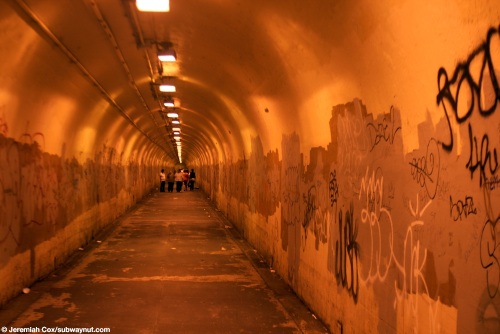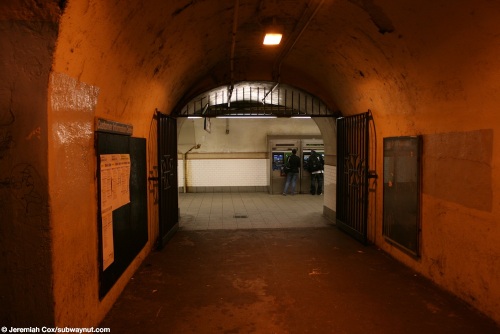





191 Street is the deepest subway station at 181 feet beneath the surface. The stop lacks the grandiose vaulted ceilings found in its counterparts in the Washington Heights Mined Tunnel (168 and 181 Streets). The stop instead has simply two side platforms all carved into the sides of the tunnel (similar to the extension portions of 168 and 181 Streets), with wide tiled over columns holding the roof of the platform up at various intervals. The reason for this construction is that this station was not originally part of the contract to build the deep Fort George Tunnel which opened through to Dyckman Street in 1906, and is at the base of Fort George Hill, which is outdoors, and daylight is clearly seen from the platforms at the deepest subway station in the system. 191 Street opened as an infill station on January 14, 1911, with the pedestrian tunnel opening as a City Street in 1913 increasing access to the station (and also relieving congestion at already overcrowded 181 Street).
Each side platform is decorated with many 191 Street name tablets most of which were replicas added during 2003 renovations that include white text on a blue background surrounded by a border of basic shapes. The trim line is complex with a dark brown outer boarder, a light brown inner boarder and grey for the background mosaics with a simple pattern of linear lines only forming right angles (in green mosaic). This same trim line is on all of the platform columns along with small 191 tiles at various intervals along the platform.
For access, the station has one enclosed mezzanine area with a curved ceiling and the station's standard tiling scheme in the center of the station from the turnstiles two staircases lead down to the downtown platform, these staircases are to the side of the platform in their own little passageways. The small mezzanine continues towards the uptown platforms where a narrower staircase forms to a small half-way landing before splitting into to even narrow staircases that lead down to the platform at 180 degree angles to their parent staircase. On the end wall of this mezzanine is where most of the Arts For Transit installation Primavera is located.
For access, since this is the deepest station in the system, that is interesting as well. The stop has two entrances beyond the fare control area at a vast distance to each other and the station is commonly walked through by residents using it as a free neighborhood shortcut to avoid the steepness of climbing up Fort George Hill. The main exit directly above the station consist of a small and narrow elevator landing for four elevators (two on each side of the narrow landing) set back behind a pizza parlor on the west side of St. Nicholas Avenue between 190 and 191 Streets that lead to an equally narrow elevator landing just beyond the turnstiles. Interestingly there are no doors into this small elevator plaza it's simply just set back from the street there is a subway station sign on the storefronts and a recently installed countdown clock on the upper landing. The two elevators on the south side of the landing have a second set of doors and these doors lead to second winder landings at the two levels but these wider landing areas have been closed off and put behind locked gates in order to create more crew quarters.
The other station entrance consists of a grimy relatively narrow (approximately ten foot wide) approximately quarter mile long tunnel (three city blocks) with bare concrete walls that have a bit of a graffiti problem. The entrance is tucked into the storefronts on the west side of Broadway across from 190 Street (which doesn't continue through because of the hill) with a restored mosaic that says IRT Subway-191 St entrance above a small regular 191 St Subway Station sign. There is another conventional looking street sign that says No Bicycle Riding in Subway Tunnel and Department of Transportation in its tiny text beneath. This tunnel isn't controlled by the subway system but is in jurisdiction of the NYC DOT officially named "Tunnel Street" and not the subways (the elevators though definitely are the MTAs one is always staffed by an MTA employee). As of 2010, at the entrance and for the first twenty feet of the tunnel at the entrance where a decently long ramp and staircase (maybe a story) leads down into the main depths of the tunnel is a huge mural on all the walls entitled New York is a Roller Coaster not a MTA Arts For Transit Commission but a Groundswell Community Mural Project sponsored by The Office of the Mayer and the Department of Transportation, there's no mention of the MTA. This has also led me to this same conclusion. The rest of the quarter mile tunnel gradually slopes downhill towards the subway station is relatively dark (with a single yellow glow of a light bulb every ten feet, and bulbs frequently out rendering a section in more darkness), with some graffiti on the walls that has been attempted to be painted over, In 2023 the tunnel was completely repainted removing all evidence of both commissioned murals and non-commissioned street art (graffiti). Just before reaching the brightness of the subway station the tunnel takes a 90-degree turn to the north almost immediately reaching the station. This turn makes the end of the tunnel less obvious.
Photos 1-9: July 24, 2008; 10-37: December 31, 2010; 38: August 16, 2007; 39-42: September 5, 2011; 43-46: October 30, 2012; 47-52: November 1, 2012; 53-56: September 27, 2012;
Arts For Transit at 191 Street
Primavera, 2003
Glass Mosaic and Faceted Glass at end of mezzanine
By Raúl Colón
Groundswell Community Mural Project in 191 Street Tunnel (Painted over by 2014)
New York is a Roller Coaster
Acrylic on Cement, 2008


Station Subway Lines (1989-2005)

